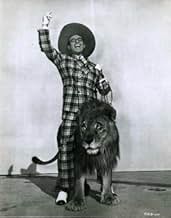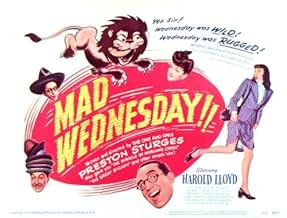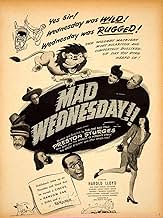IMDb-BEWERTUNG
6,3/10
1810
IHRE BEWERTUNG
Füge eine Handlung in deiner Sprache hinzuHarold is a mild-mannered clerk who dreams about marrying the girl at the desk down the aisle. But then he loses his job, and when he is offered a potent drink at a bar, he goes on a very st... Alles lesenHarold is a mild-mannered clerk who dreams about marrying the girl at the desk down the aisle. But then he loses his job, and when he is offered a potent drink at a bar, he goes on a very strange and funny rampage (with a lion in tow).Harold is a mild-mannered clerk who dreams about marrying the girl at the desk down the aisle. But then he loses his job, and when he is offered a potent drink at a bar, he goes on a very strange and funny rampage (with a lion in tow).
- Auszeichnungen
- 2 Nominierungen insgesamt
Empfohlene Bewertungen
An interesting if ultimately unsuccessful combination of two clashing comedy styles (overseen by humorless mogul Howard Hughes no less), this film turned out to be Harold Lloyd's swan-song - and, as such, it ended on a somewhat positive note (even though the film was made during Sturges' period of decline).
It opens with a reprise of the climactic football game from one of Lloyd's greatest successes, THE FRESHMAN (1925), eventually bringing that same character (albeit renamed!) up to date. Still, in the end, the film is more Sturges than Lloyd: even if the star plays one of his trademark roles of a patsy (though not without the occasional display of ingenuity), there is little of the star's characteristic slapstick here. Instead, the comedy is in Sturges' typical frantic (and, mainly, dialogue-driven) style - with which Lloyd isn't entirely comfortable; the film also features Sturges' stock company of character players in full swing. That said, it's climaxed by yet another of the star comedian's thrilling set-pieces which finds him overhanging from a building-ledge - hampered this time around by a myopic Jimmy Conlin and an understandably disgruntled circus lion!
While a disappointing whole (it was re-issued in 1950 in a shortened version renamed MAD Wednesday), the film does contain a number of undeniable gems: his romantic attachment to every female member of one particular family (all of whom happen to work for the same firm over a 20-year period); his first encounter with Conlin, with the two of them exchanging wise sayings (the optimistic Lloyd had kept a handful nailed to the wall behind him at his former workplace) in order to explain their current dejected state-of-mind; and, best of all, the unforgettable scene in which Lloyd takes his first alcoholic beverage (an impromptu concoction by bartender Edgar Kennedy and which he names "The Diddlebock") that invariably provokes an unexpected yet hilarious reaction.
It opens with a reprise of the climactic football game from one of Lloyd's greatest successes, THE FRESHMAN (1925), eventually bringing that same character (albeit renamed!) up to date. Still, in the end, the film is more Sturges than Lloyd: even if the star plays one of his trademark roles of a patsy (though not without the occasional display of ingenuity), there is little of the star's characteristic slapstick here. Instead, the comedy is in Sturges' typical frantic (and, mainly, dialogue-driven) style - with which Lloyd isn't entirely comfortable; the film also features Sturges' stock company of character players in full swing. That said, it's climaxed by yet another of the star comedian's thrilling set-pieces which finds him overhanging from a building-ledge - hampered this time around by a myopic Jimmy Conlin and an understandably disgruntled circus lion!
While a disappointing whole (it was re-issued in 1950 in a shortened version renamed MAD Wednesday), the film does contain a number of undeniable gems: his romantic attachment to every female member of one particular family (all of whom happen to work for the same firm over a 20-year period); his first encounter with Conlin, with the two of them exchanging wise sayings (the optimistic Lloyd had kept a handful nailed to the wall behind him at his former workplace) in order to explain their current dejected state-of-mind; and, best of all, the unforgettable scene in which Lloyd takes his first alcoholic beverage (an impromptu concoction by bartender Edgar Kennedy and which he names "The Diddlebock") that invariably provokes an unexpected yet hilarious reaction.
Harold Lloyd was one of Hollywood's greatest physical comedians and actors of Buster Keaton and Charlie Chaplin generation. This film marks his final performance but he could have done so much more in film. Regardless, his contributions should not be overlooked. Harold Lloyd plays Harold Dibbledock, a former football players, who ends up at a dead-end job as a clerk for 22 years. His ungrateful boss sends him packing after he fires him for years of service which was more like a prison sentence than a job. He never relived his glory days on the field. When he encounters an old man who seeks a few dollars to play the horses, he begins a new life after he takes a drink. Until then, Harold has never drank alcohol. He awakens up to learn that he's changed and doesn't have a clue about it. Margaret Hamilton plays Flora in a small performance. Anyway, he learns that he's bought a cab with a driver and a horse and a circus. Anyway, the film's best scenes are stolen by Jackie, the lion. It's a good film!
Harold Lloyd and Preston Sturges are in the same boat, really. In their respective times, they were beloved stars. Now, the rank and file don't really remember them, or if they do remember them it's for a limited selection of films which don't necessarily reflect their full bodies of work. For Lloyd, audiences really only know him as the guy who's always hanging from the clock in the Chuck Workman montages that pop up during award shows, no concept at all that he was, in his time, far more successful than Buster Keaton and on the same level as Chaplin. And for Sturges, only filmlovers really remember him, even though the best of his films, like Palm Beach Story and Sullivan's Travels are among the very best of their time.
Lloyd, of course, was a silent comedy icon. After the depression is career slumped and while he made a series of largely unsuccessful sound films trying to maintain the verve of his silent comedies, audiences simply were not interested. In 1947, though, he attempted another comeback in the film The Sins of Harold Diddlebock. Directed by Preston Sturges, Diddlebock capitalized on Lloyd's past rather than avoiding it. The film took the interesting question "What happened to Harold Lamb (Lloyd's character from The Freshman, his most popular silent film) after the Depression?" In doing so, the film also examined what happened to Lloyd's image.
Diddlebock opens with the final 10 minutes of The Freshman, the triumphant football game. Shifting to sound almost immediately after the final whistle, Lloyd's character goes from youthful exuberance to aged desperation. Following the game, we discover, Harold took a bookkeeping job at an ad agency hoping to move straight to the top. Like his character in Safety Last (the classic where he hangs from that big clock) all he wanted was the chance to pitch his one great idea. But that chance never came and nearly twenty years after he lost his savings in the Crash, Harold loses his job as well. Grey haired, face set in wrinkles, Harold goes into the world with only a small pension. But with the help of a night of drinking, a horse named after his aunt, a look-alike sister played by Margaret Hamilton (the Wicked Witch of the West), and an old boozehound named Worm, he reclaims his comic genius, briefly owns a circus with 37 lions, and, well, perhaps you can see where this late screwball comedy is going. Diddlebock went nearly a million dollars over budget and was reedited and renamed (to Mad Wednesday). It was a disaster.
Looking at the film objectively, many years later, it certainly isn't so bad. The central stylistic conceit is that the silent slapstick of Lloyd's age and the verbal acrobatics that made Sturges famous were not so different at all. Sturges goes so far as to change Lloyd's character's name from "Lamb" to "Diddlebock" to create a slapstick of nomenclature. Diddlebock also proves fairly conclusively that Lloyd's decline was not caused by an inability to handle speaking roles. In this film he keeps up his end of the witty repartee and even harmonizes in a chorus of "Auld Lang Syne." The film also pays homage to Safety Last's human fly scene with a skyscraper chase scene involving Lloyd and a lion. Even at 53, Lloyd was still fit enough to handle the stunts, including swinging upside down from a leash. And yet, for all of its charm, Diddlebock must have seemed out of place. By that point audiences probably didn't remember Lloyd and didn't want to remember the Depression.
The problem is that the film is just a little too clunky and, like the worst of Sturges's writing, relies largely on expositional monologues to justify plot contrivances. Also, the film just doesn't have the zip that Sturges's films had at their peak. Still, it's a pleasant combination of elements, capitalizing on Lloyd's considerable personal appeal, Sturges's talent (even low Sturges is better than, well, most things), and several members of Sturges's stock troupe, including Jimmy Conlin as drunk gambler Wormy. The fact that audiences of the time rejected it shouldn't have any impact on people with unjaded eyes viewing it today.
Look for the 90 minute version, by the way.
I'd give Harold Diddlebock a 7 out of 10. It's worth a look if you're a fan of either Lloyd or Sturges.
Lloyd, of course, was a silent comedy icon. After the depression is career slumped and while he made a series of largely unsuccessful sound films trying to maintain the verve of his silent comedies, audiences simply were not interested. In 1947, though, he attempted another comeback in the film The Sins of Harold Diddlebock. Directed by Preston Sturges, Diddlebock capitalized on Lloyd's past rather than avoiding it. The film took the interesting question "What happened to Harold Lamb (Lloyd's character from The Freshman, his most popular silent film) after the Depression?" In doing so, the film also examined what happened to Lloyd's image.
Diddlebock opens with the final 10 minutes of The Freshman, the triumphant football game. Shifting to sound almost immediately after the final whistle, Lloyd's character goes from youthful exuberance to aged desperation. Following the game, we discover, Harold took a bookkeeping job at an ad agency hoping to move straight to the top. Like his character in Safety Last (the classic where he hangs from that big clock) all he wanted was the chance to pitch his one great idea. But that chance never came and nearly twenty years after he lost his savings in the Crash, Harold loses his job as well. Grey haired, face set in wrinkles, Harold goes into the world with only a small pension. But with the help of a night of drinking, a horse named after his aunt, a look-alike sister played by Margaret Hamilton (the Wicked Witch of the West), and an old boozehound named Worm, he reclaims his comic genius, briefly owns a circus with 37 lions, and, well, perhaps you can see where this late screwball comedy is going. Diddlebock went nearly a million dollars over budget and was reedited and renamed (to Mad Wednesday). It was a disaster.
Looking at the film objectively, many years later, it certainly isn't so bad. The central stylistic conceit is that the silent slapstick of Lloyd's age and the verbal acrobatics that made Sturges famous were not so different at all. Sturges goes so far as to change Lloyd's character's name from "Lamb" to "Diddlebock" to create a slapstick of nomenclature. Diddlebock also proves fairly conclusively that Lloyd's decline was not caused by an inability to handle speaking roles. In this film he keeps up his end of the witty repartee and even harmonizes in a chorus of "Auld Lang Syne." The film also pays homage to Safety Last's human fly scene with a skyscraper chase scene involving Lloyd and a lion. Even at 53, Lloyd was still fit enough to handle the stunts, including swinging upside down from a leash. And yet, for all of its charm, Diddlebock must have seemed out of place. By that point audiences probably didn't remember Lloyd and didn't want to remember the Depression.
The problem is that the film is just a little too clunky and, like the worst of Sturges's writing, relies largely on expositional monologues to justify plot contrivances. Also, the film just doesn't have the zip that Sturges's films had at their peak. Still, it's a pleasant combination of elements, capitalizing on Lloyd's considerable personal appeal, Sturges's talent (even low Sturges is better than, well, most things), and several members of Sturges's stock troupe, including Jimmy Conlin as drunk gambler Wormy. The fact that audiences of the time rejected it shouldn't have any impact on people with unjaded eyes viewing it today.
Look for the 90 minute version, by the way.
I'd give Harold Diddlebock a 7 out of 10. It's worth a look if you're a fan of either Lloyd or Sturges.
This film drags in some parts, and Lloyd I think puts off some modern viewers. The first time I watched it I thought it was the film equivalent of seeing Ali vs. Andre the Giant. But Sturges' brilliance is in here, and the degree to which it is derived from Lloyd is paid homage to in a wonderful, dark, surreal way. How can you not love a film that starts with the last moments of Lloyd's The Freshman and then shows the hero turned into a mail room stooge who gets buried by the corporate system? The ending is wonderfully hypnotic, happy? Well as is always the case, the poor down trodden guy figures out how to operate the machine just enough to produce his own deus ex machina. Sturges and Lloyd look more brilliant and visionary than ever from the vantage point of post-Enron, MCI, etc.
Calling this film brilliant isn't strong enough. The Dylan lyric "to laugh and cry in a single sound" fits because at the end of the film if your heartstrings are not being strummed then you may not be living.
Lloyd is an everyman squashed by life who encounters a bartender and asks for his first drink, ever. The bartender rises to the challenge and... well, Lloyd spends part of the film piecing together what he did after consuming it... I'm telling you, this film is BRILLIANT. The way it's shot, the acting, the brilliant casting, the writing all work together in a way that has no equal in cinema; the silent version of "The Thief of Baghdad" comes to mind for its sense of unbridled fun and its soaring spirit. This is so much more than a comedy, at some point the movie glides past that label and really grabs the brass ring, you know what I mean?
Truly brilliant, highest possible recommendation.
Lloyd is an everyman squashed by life who encounters a bartender and asks for his first drink, ever. The bartender rises to the challenge and... well, Lloyd spends part of the film piecing together what he did after consuming it... I'm telling you, this film is BRILLIANT. The way it's shot, the acting, the brilliant casting, the writing all work together in a way that has no equal in cinema; the silent version of "The Thief of Baghdad" comes to mind for its sense of unbridled fun and its soaring spirit. This is so much more than a comedy, at some point the movie glides past that label and really grabs the brass ring, you know what I mean?
Truly brilliant, highest possible recommendation.
Wusstest du schon
- WissenswertesDuring the scene where Harold Lloyd's character meets Jackie the lion, on the first take when Lloyd pets Jackie, the lion actually bit him on his right hand. However, he was not injured because the lion's teeth scraped against his two prosthetic fingers (Lloyd had lost most of his right hand in an on-set accident in 1919). After that, he refused to pet the lion ever again on- or off-screen, and in the second take, which was used for the film, his terrified squirming over the lion standing next to him is genuine.
- PatzerThe story takes place in New York. It is odd to see Los Angeles City Hall in the background of the final shot.
- Crazy Credits"... and for the first time a young girl called Frances Ramsden playing the youngest Miss Otis"
- Alternative VersionenOriginally released at 90 minutes; was then re-edited and re-released in a shorter 79-minutes version under the title "Mad Wednesday" in 1950.
- VerbindungenEdited from Harold Lloyd, der Sportstudent (1925)
- SoundtracksAmerica, the Beautiful
(uncredited)
Music by Samuel A. Ward
Played during the presidential calendar montage
Top-Auswahl
Melde dich zum Bewerten an und greife auf die Watchlist für personalisierte Empfehlungen zu.
- How long is The Sin of Harold Diddlebock?Powered by Alexa
Details
- Erscheinungsdatum
- Herkunftsland
- Sprache
- Auch bekannt als
- The Sin of Harold Diddlebock
- Drehorte
- Memorial Stadium - Stadium Rim Way, Berkeley, Kalifornien, USA(football scenes edited from The Freshman)
- Produktionsfirma
- Weitere beteiligte Unternehmen bei IMDbPro anzeigen
Box Office
- Budget
- 1.712.959 $ (geschätzt)
- Laufzeit1 Stunde 29 Minuten
- Farbe
- Seitenverhältnis
- 1.37 : 1
Zu dieser Seite beitragen
Bearbeitung vorschlagen oder fehlenden Inhalt hinzufügen

Oberste Lücke
By what name was Verrückter Mittwoch (1947) officially released in Canada in English?
Antwort





































